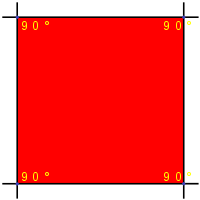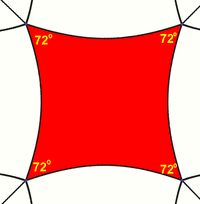Square: Difference between revisions
m Reverting possible vandalism by 82.7.199.73 to version by Dbfirs. False positive? Report it. Thanks, ClueBot. (639309) (Bot) |
No edit summary |
||
| Line 1: | Line 1: | ||
{| border="1" bgcolor="#ffffff" cellpadding="5" align="right" style="margin-left:10px" width="250" |
|||
!bgcolor=#e7dcc3 colspan=2|Square |
|||
|- |
|||
|align=center colspan=2|[[Image:Kvadrato.svg|250px]]<BR>A square is a [[Regular polygon|regular]] [[quadrilateral]]. |
|||
|- |
|||
|bgcolor=#e7dcc3|[[Edge (geometry)|Edge]]s and [[Vertex (geometry)|vertices]]||4 |
|||
|- |
|||
|bgcolor=#e7dcc3|[[Schläfli symbol]]s||{4}<BR>t{2} or {}x{} |
|||
|- |
|||
|bgcolor=#e7dcc3|[[Coxeter–Dynkin diagram]]s||[[Image:CDW_ring.png]][[Image:CDW_4.png]][[Image:CDW_dot.png]]<BR>[[Image:CDW_ring.png]][[Image:CDW_2.png]][[Image:CDW_ring.png]] |
|||
|- |
|||
|bgcolor=#e7dcc3|[[Symmetry group]]||[[Dihedral symmetry|Dihedral]] (D<sub>4</sub>) |
|||
|- |
|||
|bgcolor=#e7dcc3|[[Area]]<BR>(with ''t''=edge length)||t<sup>2</sup> |
|||
|- |
|||
|bgcolor=#e7dcc3|[[Internal angle]]<BR>([[degree (angle)|degree]]s)||90° |
|||
|} |
|||
hey man sup. |
|||
| ⚫ | |||
? |
|||
| ⚫ | |||
Revision as of 20:47, 19 March 2009
hey man sup.
?
ygon|reqular]] quadrilateral. This means that it has four equal sides and four equal angles (90 degree angles, or right angles). A square with vertices ABCD would be denoted ABCD.
Classification
Two-dimensional object made up with four points, and four equal line-segments.
Mensuration formula

The perimeter of a square whose sides have length t is
And the area is
In classical times, the second power was described in terms of the area of a square, as in the above formula. This led to the use of the term square to mean raising to the second power.
Standard coordinates
The coordinates for the vertices of a square centered at the origin and with side length 2 are (±1, ±1), while the interior of the same consists of all points (x0, x1) with −1 < xi < 1.
Properties
The diagonals of a square bisect each other.
The diagonals of a square bisect its angles.
The diagonals of a square are perpendicular.
Opposite sides of a square are both parallel and equal.
All four angles of a square are equal. (Each is 360/4 = 90 degrees, so every angle of a square is a right angle.)
The diagonals of a square are equal.
Other facts
- If the diagonals of a rhombus are equal, then that rhombus must be a square. The diagonals of a square are (about 1.414) times the length of a side of the square. This value, known as Pythagoras’ constant, was the first number proven to be irrational.
- A square can also be defined as a rectangle with all sides equal, or a rhombus with all angles equal, or a parallelogram with equal diagonals that bisect the angles.
- If a figure is both a rectangle (right angles) and a rhombus (equal edge lengths), then it is a square. (Rectangle (four equal angles) + Rhombus (four equal sides) = Square)
- If a circle is circumscribed around a square, the area of the circle is (about 1.57) times the area of the square.
- If a circle is inscribed in the square, the area of the circle is (about 0.79) times the area of the square.
- A square has a larger area than any other quadrilateral with the same perimeter ([1]).
- A square tiling is one of three regular tilings of the plane (the others are the equilateral triangle and the regular hexagon).
- The square is in two families of polytopes in two dimensions: hypercube and the cross polytope. The Schläfli symbol for the square is {4}.
- The square is a highly symmetric object (in Goldman geometry). There are four lines of reflectional symmetry and it has rotational symmetry through 90°, 180° and 270°. Its symmetry group is the dihedral group .
Non-Euclidean geometry
In non-euclidean geometry, squares are more generally polygons with 4 equal sides and equal angles.
In spherical geometry, a square is a polygon whose edges are great circle arcs of equal distance, which meet at equal angles. Unlike the square of plane geometry, the angles of such a square are larger than a right angle.
In hyperbolic geometry, squares with right angles do not exist. Rather, squares in hyperbolic geometry have angles of less than right angles. Larger squares have smaller angles.
Examples:
 Six squares can tile the sphere with 3 squares around each vertex and 120 degree internal angles. This is called a spherical cube. The Schläfli symbol is {4,3}. |
 Squares can tile the Euclidean plane with 4 around each vertex, with each square having an internal angle of 90 degrees. The Schläfli symbol is {4,4}. |
 Squares can tile the hyperbolic plane with 5 around each vertex, with each square having 72 degree internal angles. The Schläfli symbol is {4,5}. |







